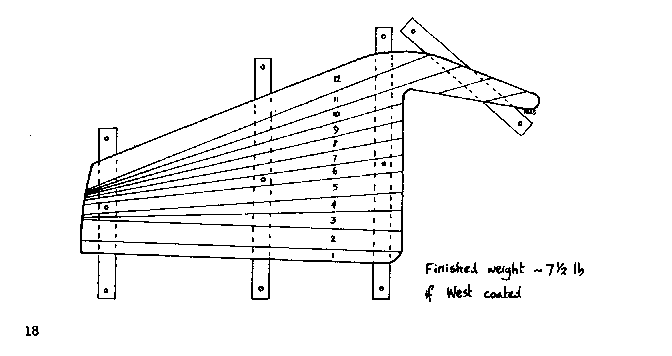You are here: okdia.org > technical > technical manual > building centerboard
Technical Manual
Make Your Own Super Centreboard
by John Bottomley
The technique John Bottomley describes can be used for rudder as well as centreboard construction, and is both simple and effective. It is possible to obtain similar weight reduction by constructing hollow foils, and some owners may prefer this technique, though there are obvious potential weaknesses if the construction is not up to standard.
Foils, like sails, do not last anything like as long as the boat. So most of us are faced, at sometime in our career, with engineering a replacement.
This happened to me when building my new boat. Being unable to afford the enormous cost of a proprietary brand of laminated board and not being satisfied with the standard of the run of the mill plywood alternative, I decided to laminate my own.
The shape of my laminates was designed to allow for maximum length glue lines and also allowed top and tailing and back-to-fronting the wood which helps to prevent warping by balancing out the internal stress.
I do not intend telling in any great detail how to shape the section of the board. Suffice it to say that the point of maximum cord should be about 1/3 way aft, the leading edge should be parabolic and aft edge a flat about 1mm wide. These details are well documented and explained in many sailing books.
To assist in obtaining the same section on both sides, I made three templates out of 5mm ply. These gave the section that I thought I required at the top, middle and tip. I then sectioned these areas and trued the remainder of the board.
DO NOT FORGET to put the centre line round the edge of the board before you start to section!!
To manufacture a board, you need a true surface. To obtain this, screw a piece of 2" x 2" wood onto the garage floor. Ensure that it is square and straight. You can check it by placing your 3' spirit level on the wood with several 1" wide strips of newspaper spread along the length underneath it. If it is straight, all the strips are tight. Use wedges and wood strips to pack it straight and level.
Fix the next batten alongside the first. The sketch shows how the battens are laid out. This has to be very carefully packed and secured so that it lies with its surface exactly flat and level with the first piece. By repeating the operation twice more, the true 'surface' is produced.
Now lay the strips of wood in correct order over the surface and assemble "dry". Then draw the full size outline of the board onto the assembly to give a guideline for re-assembly of the glued laminates.
Dis-assemble and lay a polythene strip over each of the 2" x 2" battens to prevent the board from sticking to them and set up a straight edge secured to the battens (I used a 3" nail at each batten) to rest the trailing edge against.
Now apply glue to the inner edge of the trailing edge piece and place it hard against the straight edge. Glue up both edges of the second piece (if you are going to put on more than one strip at a time) and lay it in place RIGHT WAY ROUND (!!) Repeat until you have as many pieces in as you inter to glue in one session and then drive a nail into each batten about 1/8" clear of the outer strip. Next drive in a little wedge at each nail into the gap to wedge the glue lines tight. I used the halves of the spring type clothes pegs, but you can make some little wood wedges.
As soon as pressure is applied, the wedge shaped pieces of board, being lubricated by the glue, slide out of line. To prevent this, I used a staple gun to put a few staples across the glue line. In this way, you can build up half the width of the board without trouble in one session, saving time and with much less wastage of glue.
However, as you get further from the straight edge, the strips will tend to lift off the surface. So you will need to apply weights (I used a number of house bricks) to hold them down onto the 'surface'. Have a good supply ready in advance.
After the glue has 'gone off', re-draw the outline accurately. Drill a small pilot hole at the pivot point to ensure that the outline is correctly 'located' on the pivot. Then cut to the outline.
Then comes the hard work bit. Plane the section. Three words - hours of work, sweat and toil. Spend as much time sharpening the plane as planing and work the plane on the screw which minimises the tendency for it to 'pick out' the grain to which mahogany is very prone.
Now for the contentious bit. Either varnish, paint or whatever, or cover with glass cloth and impregnate with Epoxy. Make sure you get a cloth that is compatible with epoxy resin as the binder of some polyester cloths (GRP) is not. Apply the resin until the surface is smooth. Then cut back with wet and dry paper and polish.
CUTTING LIST
| ITEM | SIZE | MATERIAL | |
|---|---|---|---|
| 1 | 1m | 35mmby 19/20mm* | Mahogany |
| 2 | 1m | 60mmby 19/20mm | Western Red Cedar |
| 3,4 | 1m | 60mmby 19/20mmcut diagonally | Western Red Cedar |
| 5 | 1m | 60mmby 19/20mm | Western Red Cedar |
| 6,7 | 1m | 60mmby 19/20mmcut diagonally | Western Red Cedar |
| 8,9,10,11 | 1.5m | 60mmby 19/20mmcut diagonally | Western Red Cedar |
| 12 | 1.5m | 60mmby 19/20mm | Mahogany |
*Use l9mm if the board is to be sheathed.
1kg epoxy resin
l.5m by 1.5m 6oz woven glass cloth
Illustrations

Note
The SP Guide to Wooden Foil Construction, from Volume 5, also reproduced in this series, provides more detailed information.










